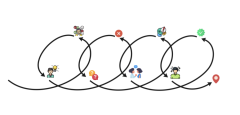Conclusion: after I talk to this expert and did some research, I decided to combine her opinions and my original opinions to iterate my career model. Both of our opinions are right in their own way. But it also shows that each of us has our own positionality. So I think combining these two is a better way since this model is neither perfect nor the end, but a reference for my audiences, like giving the light in the dark, and an inspiration for them to think about their own personalized models.
Apart from that, she mentioned the ability to appreciate others, and be interested in others work and be kind. I think that is a great point, especially for art students, most of them are too confident and need to be humble. So I’ll iterate my career model by adding it.

https://www.surveymonkey.com/results/SM-KD7QLYD29/
I sent this email to ten UAL Fine Art staff and I received three replies. Although the quantity is not very large, I think the quality is good. Because two of the responses are the Fine Art course leaders. And I also had a deeper conversation with Patricia.
The result of the average rating is:
Organized ability: 5 stars
Communication ability: 5 stars
Cooperative ability: 4.3 stars
Business ability: 3 stars
After I got the questionnaire results and did research about those three artists, I am thinking about my definition of business ability.
Before art students graduate, they can freely pursue their own painting styles and favourite theme in universities studio. But when they need to face the problem of supporting themselves after graduation, maybe their personality style can’t make money quickly. So I think they need to have the ability to produce profitable commercial work which they may not like. But at the same time, art graduates can continue to pursue what they are really interested in.
It might work for some art graduates. But they need to be careful to balance the critical practice and commercial practices.
Like what Patricia said, 1. Artists should always focus on making their work in a way that is most interesting for them. If you’re trying to appeal to the market for the sake of making money your practice likely won’t get very far (and you’ll lose interest). 2. The market is hard to predict and trying to please someone else is no way to live.
I don’t mean to throw out my original definition, I think it’s worth being. At least it could give some art graduates new thought when they face problematic employment. But Patricia’s opinion also makes sense. I will combine it together and evaluate my model.
In addition, I also noticed her positionality.
Those who can pursue their art regardless of financial considerations, and those who are extremely talented enough to wear several hats and combine their artistic pursuits with other work, are a minority.
But her opinion also makes sense. When the path of art is narrow, art graduates need to be able to deal with multiple identities. And, how to balance those different identities really depends on different individuals.
